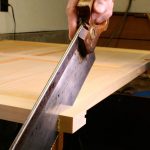We may receive a commission when you use our affiliate links. However, this does not impact our recommendations.

Center the grooves. The 3/4" x 3/4" grooves must be centered in the width of the post to make the fit (and the sanding) acceptable. A careful setup with a dado set makes this quick work.
If you’re concerned about copying another person’s design, keep in mind what Maloof said in his book “Sam Maloof, Woodworker” when asked about those who copy his furniture: “This reminds me of an anecdote about Hamada, the Japanese potter. When someone asked Hamada if imitations of his work bothered him, he replied, ‘When I’m dead, people will think that all of my bad things were made by the other potter, and they will think that all of his good things were made by me.’ ”
1. Starting at the Post. The first step is roughing out and shaping the base’s center post. The post measures 3″ x 3″ x 23″, and unless you’re very lucky you’ll have to glue up a couple boards to achieve this dimension. Using 1 3/4″ thick material, I was able to glue up two 3″-wide pieces with room to spare.
If you’ve ever tried to glue two flat pieces together you know that glue works like butter, and the wood wants to slip apart. Drill two dowel holes on the matching faces and use dowels as guide pins during gluing so you won’t fight with your pieces.

Make careful coves. Getting the cove cuts to align with the edges of the leg centers makes sanding and the final finish easier. If anything, allow the cove cuts to be a hair wider than necessary so that the sanding to fit occurs on the leg centers, not in the cove cut.
Next run the post down to 3″ x 3″. You should leave the post longer than the finished 23″ for now to allow for fitting. The first milling procedure is to use a dado stack to cut grooves the length of the post on all four faces.
2. Forming the Inside Curve. With the post grooved to accept the leg tenons, make cove cuts on the four corners so that the shape flows into the legs. I accomplished this with a 3/4″ cove bit. This bit is a $50 necessity. There is no other tooling that provides the control given by a router and bit set up in a router table.
As shown in the photo, the location of the cove cut is critical to how easy it will be to assemble the base and how good it will look. Use two passes of increasing depth to put less stress on your router.

Dowel the legs. Use dowels to join the leg tops and bottoms to the leg center. I used 1/2" dowels, which were later pinned through the side of the legs with 1/8" dowels. A self-centering doweling jig like the one shown in the photo takes some of the measuring out of this step.
Here are some supplies and tools we find essential in our everyday work around the shop. We may receive a commission from sales referred by our links; however, we have carefully selected these products for their usefulness and quality.







